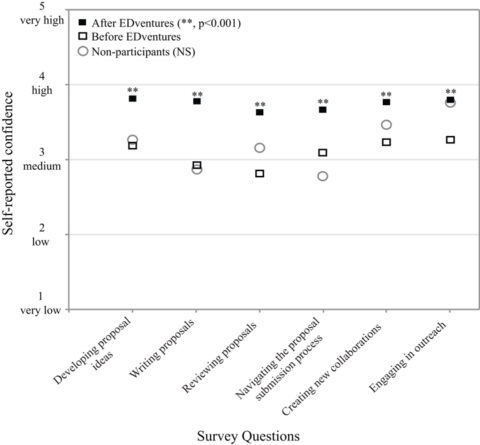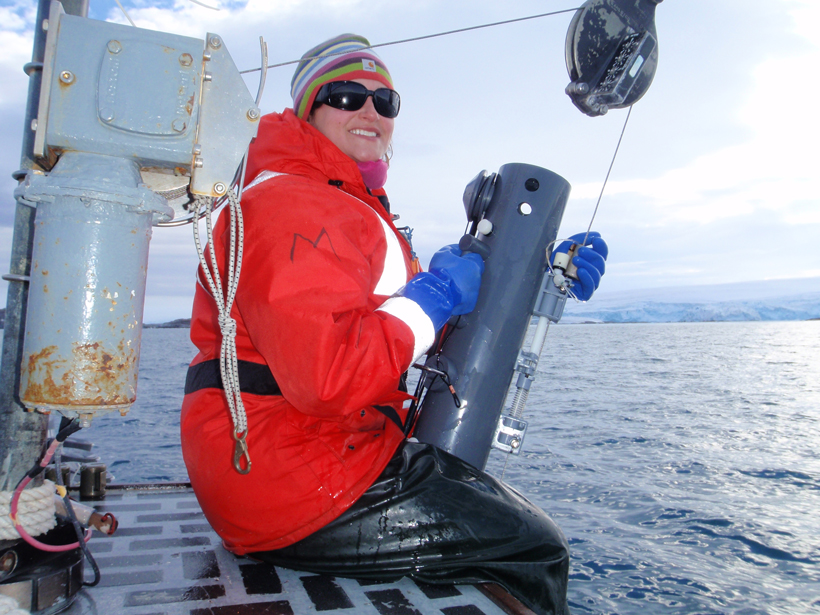All scientists, no matter how talented, need to know how to secure funds to support their research. But many scientists make it all the way to faculty positions without any substantial training in how to write successful grant proposals. This shortfall can imperil otherwise promising careers.
If your institution does not offer proposal writing training to graduate students and postdocs, we encourage you to fill this critical gap. To help, we present an innovative program, EDventures, as a model of real-time proposal-writing training with a built-in reward: the possibility of receiving funding for the proposed activities.
Any research group or department can create an EDventures program; the only costs involved are the pot of money made available to proposers and a bit of faculty time.
Learning by Doing
Created by the National Science Foundation (NSF)-sponsored Center for Microbial Oceanography: Research and Education (C-MORE), a multi-institutional center based at the University of Hawai‘i at Mānoa, EDventures awards seed funding for educational activities. Graduate students and postdocs build skills by both writing proposals and executing funded projects.
Skills are built not only through writing proposals and executing the project but also through reviewing their peers’ proposals.
Rather than providing training before participants start writing, the EDventures model encourages students and postdocs to write proposals based on guidelines provided in the request for proposals. Proposers receive training during the review stage, when they receive feedback specific to their proposal.
EDventures also encourages graduate students and postdocs to serve as reviewers. This adds a third layer of training: Skills are built not only through writing proposals and executing the project but also through reviewing their peers’ proposals.
A Friendly Review Process
As at many funding agencies, EDventures panelists first review proposals independently and then convene to reach a consensus. What happens between these two stages, however, is not at all typical: reviewer comments, criticisms, and requests for clarification are shared with proposal authors, who are invited to revise and resubmit their proposals before the panel convenes.
Since its creation in 2007, EDventures has awarded funding for 40 of 51 (~78%) proposal submissions. By contrast, most funding agencies fund only a minority of proposals. As EDventures funds only high-quality proposals, we attribute our anomalously high success rate to the user-friendly review process. Like manuscript peer reviews, proposal peer reviews can dramatically increase quality.
Any organization that creates an EDventures program can freely establish its own guidelines. Our program employs NSF merit review criteria and accepts three proposal types: research proposals focusing on “high-risk, high-reward” studies, training proposals geared toward developing new skills, and outreach proposals. Any C-MORE personnel (including faculty and staff) can submit outreach proposals, but only students and postdocs can submit research or training proposals.
Logistical Considerations
When creating an EDventures–like program, it is important to establish a management team to review the panel’s funding recommendations, make a final decision, ensure that proposal budgets follow institutional and funding agency guidelines, and administer the transfer of awards. The management team should include principal investigators with broad knowledge of your organization’s research and outreach missions. In cases where the management team does not follow the panel’s recommendation, they should communicate their reasons to the review panel, thereby providing an opportunity for additional training.
We highly recommend appointing a senior graduate student or postdoc to serve as program manager.
We highly recommend appointing a senior graduate student or postdoc to serve as program manager. She or he will advertise the program, coordinate proposal submission and review, recruit panelists, and serve on the management team. We also recommend the program manager create a website or Facebook page to share the request for proposals, submission dates, and abstracts of previous awards.
This role will train an early-career scientist in project management while reducing faculty workload. This experience can be a valuable contribution to the CV of an early-career researcher because it builds skills in project management, tracking budgets, grantsmanship, interacting with senior personnel, and social media. Depending on the number of proposal cycles per year and the number of submissions per proposal cycle, acting as program manager may require a fair amount of work. If possible, consider factoring these extra responsibilities into the program manager’s normal working hours as a graduate student or postdoc, to ensure she or he is not stretched too thin.
Delivering Success
What imprint has EDventures made on students’ and postdocs’ careers? To find out, we administered an anonymous online survey to 187 C-MORE personnel and alumni, regardless of their participation in EDventures.
We received 61 nonblank responses, including 35 from students and postdocs. Of these respondents, 22 (63%) were proposal authors and/or reviewers; the remaining 13 (37%) did not participate in EDventures in any way. A total of 34 EDventures awards was granted to students and postdocs over the program’s 9-year history; thus, the 22 participant respondents represent a 65% return rate. Although selection bias is always possible, this high return rate suggests a representative sample.
We evaluated program success in three ways: (1) subjectively, on the basis of participant self-reporting, (2) objectively, on the basis of subsequent proposal success rates, and (3) anecdotally, through success stories.
Participant Self-Reporting

The survey included six Likert scale questions, which asked respondents to report their self-confidence at various aspects of the proposal process on a scale of 1 (very low) to 5 (very high) before and after participating in EDventures. Nonparticipants simply answered each self-confidence question once.
Four questions concerned the proposal process: developing ideas, writing, reviewing, and submitting. Two questions focused on fostering collaborations and engaging in outreach. We used a two-tailed t test to evaluate mean “before” versus “after” differences.
For each question, mean confidence increased significantly from before to after program participation (paired t test; all p <0.001; Figure 1). Mean “before” values ranged from 2.82 to 3.27 (which we termed medium confidence), and mean “after” values ranged from 3.64 to 3.82 (high confidence). Unsurprisingly, the responses of nonparticipants and those of participants before they took part in the program were not significantly different (unpaired t test, all p > 0.16).
Subsequent Funding Success
Subsequent to receiving EDventures awards, 22 program alumni reported they had submitted 36 proposals (~1.64 proposals per alumnus) to outside agencies. Impressively, 13 of the proposals were funded. Since five are still pending, alumni currently have a 42% success rate.
Of the 31 proposals on which a decision has been made, 12 were submitted to NSF, including 10 to NSF directorates and 2 to the Graduate Research Fellowship Program (GRFP). The NSF proposals had an astonishing 50% funding rate: 5 directorate proposals and 1 GRFP proposal were funded. This compares extremely favorably to the 22% cross-directorate funding rate for early-career scientists [NSF, 2014]. Clearly, EDventures participants are well positioned for professional success.
Success Stories
Anecdotally, EDventures alumni have had several notable successes over the years. Here we highlight two examples.
Graduate student Christopher Schvarcz’s proposal began with training at a Joint Genome Institute genomics workshop, followed by research to sequence genomes from previously undescribed marine viruses. Schvarcz discovered that some of these viral genomes encoded for carbon utilization pathways previously thought to exist only in cellular life. Unexpected discoveries such as these challenge our perception of viruses as simply packets of viral code. Schvarcz presented this research at the 2014 Ocean Sciences Meeting [Schvarcz and Steward, 2014].
Regarding outreach, former postdoc Angelicque White developed an interactive website to illustrate how marine microbes transfer energy and matter in the ocean. This highly visual project inspired the art show The Art of Plankton, Form Follows Function, which featured work from 35 Oregon artists based on White’s plankton images [Houtman, 2012]. Dr. White is now an associate professor at Oregon State University.
Positive Feedback
Feedback received from proposal authors and reviewers on the C-MORE EDventures program has been overwhelmingly positive. We acknowledge that EDventures participants are self-selecting; they came to the program with a desire to develop projects, improve their proposal skills, and make progress in their professional development. Nevertheless, the EDventures program rarely received negative reviews.
Students and postdocs have reported that developing projects based on their own ideas rewarded them with a sense of professional independence and helped them progress toward careers as principal investigators. They reported enjoyment and satisfaction in completing projects and sharing results, often in presentations or publications. Many found the proposal-specific feedback received through the two-stage peer review process to be highly useful—considerably more so than the generic proposal-writing training typically received in a workshop.

EDventures award recipient Mónica Rouco Molina (Figure 2) recounted, “The constructive criticisms and suggestions from the EDventures review panel helped me improve certain aspects of the proposal, such as the level of detail to use when describing data analysis tools, contributing to a better quality of the final project.” Dr. Rouco was a C-MORE postdoc and is now a lecturer at the Lamont-Doherty Earth Observatory at Columbia University.
Review panelists also reported receiving valuable training. Beyond discussing the proposed science, the panel review and discussion often provided insights that improved their own proposal writing skills. They also learned about the more technical aspects of proposal writing, such as federal per diem limits and subcontracts.
Former panelist Jessica Fitzsimmons noted, “Not only did [reviewing EDventures proposals] improve my own proposal writing, especially for the shorter proposal length required by EDventures, but it also helped me identify the most common proposal writing pitfalls for students I mentor, which improves their proposal writing as well.” A former C-MORE graduate student, Dr. Fitzsimmons is now an assistant professor at Texas A&M University.
Participants’ proposal-writing skills, particularly for NSF proposals, improved through program participation.
Management team member Paul Kemp concurred with the self-assessments of Rouco, Fitzsimmons, and others that participants’ proposal-writing skills, particularly for NSF proposals, improved through program participation. Dr. Kemp, who is associate director of C-MORE and former NSF deputy division director, noted, “C-MORE graduate students and postdocs were able to improve their NSF proposal writing skills because the C-MORE management team decided to model EDventures after the NSF proposal process.”
An Adaptable Program
EDventures has been shown to increase participants’ self-confidence in the proposal process, and it has the potential to increase the number and quality of subsequent proposals produced by early-career scientists. The program, which is nearing the end of its grant period, has received very positive reviews from participants.
The EDventures model can easily be adapted to fit any research program or budget. Program project funding amounts can be modest (e.g., $10,000–$30,000 per year), and proposal categories (e.g., research, training, and outreach) can be readily adapted to fit your program’s goals and objectives.
If your organization is looking for ways to help early-career scientists become better grant writers, we hope you will consider EDventures as a model. For more information, please visit the EDventures website, or contact the lead author.
Acknowledgments
EDventures is supported through C-MORE (NSF/EF04-24599).
References
Houtman, N. (2012), Forms from the sea: Oregon artists reveal hidden worlds in plankton science, Terra, Fall Newsletter. [Available at https://oregonstate.edu/terra/2012/10/forms-from-the-sea/.]
National Science Foundation (NSF) (2014), Merit review process report to the National Science Board, Arlington, VA. [Available at https://www.nsf.gov/nsb/publications/2014/nsb1432.pdf.]
Schvarcz, C. R., and G. F. Steward (2014), Genomic characterization of two novel nucleo-cytoplasmic large DNA viruses (NCLDVs) from the open ocean, poster presented at the 2014 Ocean Sciences Meeting, Am. Soc. of Limnol. and Oceangr., Honolulu, Hawaii. [Available at https://www.sgmeet.com/osm2014/viewabstract.asp?AbstractID=15837.]
Author Information
Elisha M. Wood-Charlson, Center for Microbial Oceanography: Research and Education (C-MORE), University of Hawai‘i at Mānoa, Honolulu; email: [email protected]; and Barbara C. Bruno, C-MORE, University of Hawai‘i at Mānoa, Honolulu
Citation: Wood-Charlson, E. M., and B. C. Bruno (2015), Teaching the art and science of getting research funding, Eos, 96, doi:10.1029/2015EO038259. Published on 2 November 2015.
Text © 2015. The authors. CC BY-NC-ND 3.0
Except where otherwise noted, images are subject to copyright. Any reuse without express permission from the copyright owner is prohibited.

